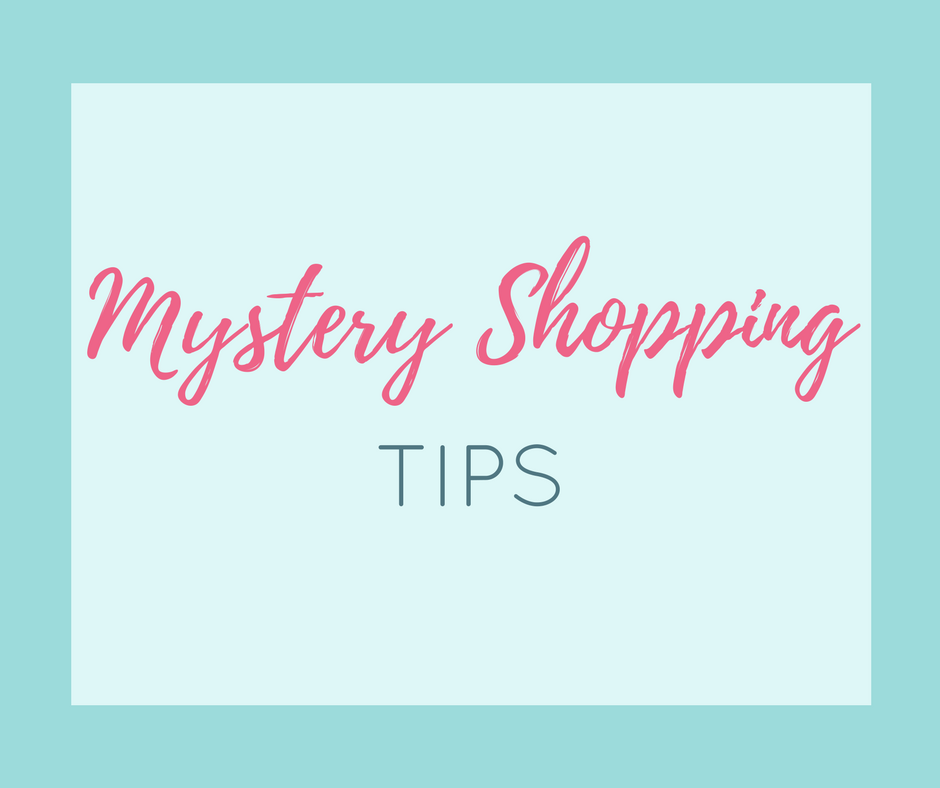Mystery Shopping Tips
Mystery shopping is a great way to measure your customer experience and learn how well your locations are following brand standards. A lot of thought...
6 min read
Mary Dubrule July 11, 2018

Customer experience (CX) is a top priority for most businesses, but many struggle to pinpoint where the brand vision for CX is not being delivered - especially at the individual location level.
Even with CX-focused training in place for employees, it is difficult for multi-location businesses to ensure processes are followed consistently at every location. The result is a disconnect between the overall CX plan and execution, and ultimately, the experience each customer has.
Mystery shopping provides a powerful way for businesses to address this disconnect as they’re able to gain valuable intelligence on CX, which is the totality of the experiences a customer has with your brand, as well as with customer service, which is the micro-level assistance your staff provides to a customer. Addressing both areas with a mystery shopping program enables businesses to ensure that the goals of CX initiatives (such as increased customer loyalty) and customer service become a reality, as you measure — and manage — what’s happening at the location level.
Many times, business owners and operators lack the insight needed at the individual location level to identify specific issues that need focus. It can be easy for challenges to go unaddressed as they aren’t always obvious to identify. If specific actions aren’t being taken, such as improving selling skills or ensuring training compliance, you might not see a decline in numbers, but you also won’t see any improvements.
The truth is, what gets measured gets managed, so if there’s not a process in place to measure employee performance against brand standards, there’s no way to get an accurate picture of where employees are performing well, and what needs improvement. An experience that is subpar to brand expectations can leave the business open to a fractured customer experience which can negatively impact key performance indicators (KPIs) in the form of customer dissatisfaction, poor reviews, and ultimately lost sales.
Forrester’s Customer Experience Index (CX Index) demonstrates the power of how incremental purchases driven by loyalty and retention impact a businesses bottom line. The index illustrates the revenue upside for a big box retailer that boosts their CX index score by a single point, results in a revenue increase of $244 million.
With the right expertise and a well-designed program, mystery shopping ensures consistent measurement of employee performance and adherence to brand standards across locations.
Here are three steps to get more value out of your mystery shopping program:
Mystery shopping isn’t just about identifying operational deficiencies; it’s about helping the company achieve business goals. So when it comes to designing a program, it’s about more than the questionnaire.
The design of a mystery shopping program should include buyer persona creation and customer journey mapping — before determining the criteria for evaluation. The program needs to be designed with a thorough understanding of customer needs so that employees are measured on internal standards that have the greatest impact on brand consistency and customer satisfaction.
A simple place to get started is by determining the business metrics you are hoping to improve. Look for behavioral or operational elements that drive the business as these will hint at the KPIs your program should focus on.
Keeping in mind the broader goals of your organization, you can then determine program goals and how each piece of the strategy supports KPIs. These program goals can be refined into smaller goals that are disseminated across various teams so that current standards are being met, or actions are being taken to ensure necessary changes are made.
You may decide the key areas of focus are employee helpfulness, merchandise layout, and change room tidiness. Each of these areas can be broken down further into smaller initiatives. Under employee helpfulness, the measurements may be for greeting and product knowledge — both of which tie back to the overall goals of the CX program. The first round of mystery shops could then focus only on employee helpfulness, knowing that subsequent shops can be done to address the other two areas.
When designing a mystery shopping program, keep in mind that the focus shouldn’t be on trying to fix everything all at once. The most successful and valuable mystery shopping programs are specific and focus on measuring one area at a time. This approach enables businesses to measure a specific area, address any challenges, refine it, and then move to the next area. Then, this cycle can be repeated over and over to tackle each area that needs improvement.
Finally, as part of the program design, ensure you’re addressing the unique needs of your operation at every location and taking steps to get a complete view of what’s happening across all locations.
For mystery shopping to be truly impactful, there needs to be time spent not just collecting data but on analyzing and acting on that data. Data needs to be viewed from the person to location, to store-wide level so action can be taken with fully transparent knowledge of performance. Only then can you unlock the full value of mystery shopping and improvements can be made that truly impact the bottom line, such as larger transaction sizes and increased sales.
Detailed reporting is required so stakeholders can view the entire picture or just the information that is relevant to them, right down to specific location level occurrences during a period of time. As mystery shopping requires multiple visits to collect a large sampling of data, having detailed reporting enables action to be taken as data is collected and analyzed.
Business owners and operators need a real-time feed of top performance issues so improvements can be made as required. Waiting to take action on issues that have been identified means missed opportunities for immediate improvement in your overall customer experience.
Michael Burandt owns and operates three successful Cinco restaurants in the Metro-Atlanta area. He wanted to use mystery shopping as a way to address concerns with the cleanliness, food quality and the service of his restaurants like most restaurant owners and managers. Insights from mystery shopping were communicated to staff and processes such as additional training were put in place to address performance gaps which immediately had a positive impact on employee work ethic.
“The staff loves seeing the reports and get very excited as they wait for the next one to come out. Mystery shopping has helped me build a phenomenal team that I am VERY proud of!” - Michael Burandt, Cinco
To use another example of how mystery shopping has helped improved efficiencies and performance, one chain of wine stores with over 120 locations made the move from a semi-annual review of data to collecting information as it happens through mystery shopping and a customer satisfaction survey program, which has made a tremendous difference.
Now that they have a dashboard that can be accessed across the organization, they’re able to drill down on key areas, and opportunities for improvement as they arise. They get alerts if there’s a low score, and busy managers are able to pinpoint specific areas of concern.
Plus, they can also recognize teams with 100% scores and use what’s being done well as an example for other locations and as an opportunity to create improved training for employees.
Mystery shopping isn’t just about measurement but managing what’s been learned to make improvements across the organization.
Working with your mystery shopping provider, you may need to create custom reports on your most important KPIs so there’s a focus on the unique information your organization needs to be successful. This customization is important as the goal is to identify specific actions in your organization that need to be taken and how those, over time, can impact the organization’s KPIs.
The data collected from mystery shopping programs can also be used as a way to reward and recognize good performance. The program shouldn’t be solely focused on uncovering areas that require improvement or only serve to highlight problems.
Mystery shopping provides an opportunity to pinpoint where teams are doing well, helping to identify what’s working with CX. This can be used to help reinforce or replicate these actions and to provide employees with positive feedback.
Creating a link between mystery shopping data and KPIs around location performance — and even employee retention numbers — demonstrates to teams how they contribute to the broader company goals. This empowers employees to be more invested in the company’s mission, values and procedures, which has consistently shown to positively impact compliance with operational standards and improved customer service.
A leading brick and mortar retailer in the motorcycle industry with over 125 locations, serves as an excellent example of the positive impact a well-executed mystery shopping program can have.
Through mystery shopping and subsequent analysis, they’ve been able to measure all aspects of their business, including marketing, product presentation, daily procedures, sales processes, staffing, and employee product knowledge. Additionally, overall sales have gone up, add-ons have increased, as well as average transaction.
Another example of turning data into actionable insights is what the Medicine Shoppe Canada has done with their mystery shopping program. According to their director of National Operations, Jon Johnson, the data they gathered was very important to targeting improvements within their chain.
Johnson explains, “We specifically noted an opportunity with our loyalty program and have since brought forth a number of changes to enhance and improve this program for our owners."
"I would recommend Intouch Insight to any business that is passionate about measuring customer service and making system improvements.” - Jon Johnson, Medicine Shoppe Canada
Deciding to implement a mystery shopping program at your organization can open up entirely new opportunities to improve customer experience. By creating a channel to gather unbiased feedback and data on what’s happening in all locations, you will be better positioned to create a consistent experience — no matter where your customers interact with your business.

Mystery shopping is a great way to measure your customer experience and learn how well your locations are following brand standards. A lot of thought...

When it comes to dining out, there’s no doubt that customers expect a seamless experience - delicious food, great service, and a pleasant atmosphere....

Keeping experiences consistent, both in-person and online has never been more important. Over the past year, we’ve seen a significant acceleration in...